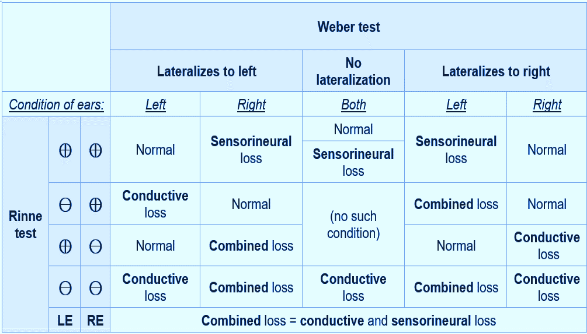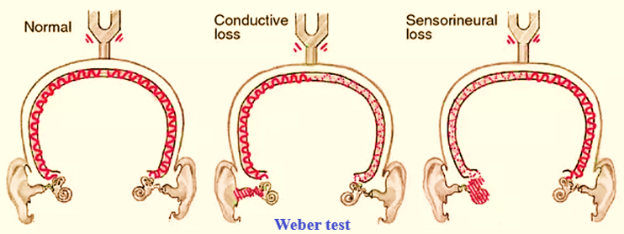
WEBER TEST
Introduction: The Weber test is a useful, quick, and simple screening test for the evaluation of hearing loss. The test can detect unilateral conductive and sensorineural hearing loss.
The External and Middle ear mediate conductive hearing. The Inner ear mediates sensorineural hearing. The Weber test is often combined with the Rinne test to detect the location and nature of hearing loss.
History: The test is named after Ernst Heinrich Weber (1795–1878).
Aim:
The Weber test, along with its paired Rinne test, is commonly used to distinguish the site and likely cause of hearing loss.
Conductive hearing loss is due to any pathology with the sound-conducting system, while sensorineural hearing loss is due to problems with the sound-transducing system, the auditory nerve or its central pathways. Occasionally, one can get a mixed hearing loss, which is a combination of the two-hearing loss.
Principles of Weber test:
In normal hearing, an individual will hear equally on both sides of the ear. The Weber test is a test of lateralization and is of most value useful in those with an asymmetrical hearing loss.
The inner ear is more sensitive to sound via air conduction than bone conduction (in other words, air conduction is better than bone conduction).
In the presence of a purely unilateral conductive hearing loss, there is a relative improvement in the ability to hear a bone-conducted sound. This can be explained by the following:
- Masking effect: The sound heard via the affected ear has less environmental noise reaching the cochlea via air conduction (for example, the environmental noise is masked) as compared to the unaffected ear which receives sounds from both bone conduction and air conduction. Therefore, the affected ear is more sensitive to bone-conducted sound.
- Occlusion effect: Most of the sound transmitted via bone conduction travels through to the cochlea. However, some of the low-frequency sounds dissipate out of the canal. A conductive hearing loss (in other words, when an occlusion is present) will, therefore, prevent external dissipation of these frequencies and lead to increased cochlear stimulation and increased loudness in the affected ear.
In the presence of sensorineural hearing loss, the sound will be perceived louder in the unaffected ear which has the better cochlear.
Procedure of Weber test:
An ideal tuning fork of choice for the Weber test would be one that has a long period of tone decay, in other words, the tone maintains and lasts long after the tuning fork has been struck and cannot be detected by sense of bone vibration. Therefore, preventing misinterpretation of the vibration as sound.
In clinical practice, the 512-Hz tuning fork has traditionally been preferred. At this frequency, it provides the best balance of time of tone decay and tactile vibration. Lower-frequency tuning forks like the 256-Hz tuning fork provide greater tactile vibration. In other words, they are better felt than heard. Higher-frequency tuning forks, for example, the 1024-Hz tuning fork, have a shorter tone decay time.
- Ideally, the test should be carried out in a quiet room.
- Verbal consent should be gained prior to performing the test.
- Clear instructions should be given to the patient to avoid misinterpretation of the test.
- A tuning fork generally consists of the tines (the U-shaped prongs), the stem, and the footplate.
- Hold the tuning fork by the stem between the thumb and first finger.
- Strike the tines one-third of the way from the free end of the prong onto a firm but the elastic object (e.g., the clinician’s knee or elbow). This will produce a relatively pure tone.
- Avoid striking the tines onto a hard surface as this may damage the tuning fork and produce multiple overtones.
- Place the vibrating tuning fork on the vertex (other common sites used are the midline of the forehead, bridge of the nose, and chin), equidistant from both ears. These vibrations will be conducted through the skull and reach the cochlea.
- Ask the patient whether it is heard loudest in either one side or the midline (e.g., “Is the sound louder in your right ear, left ear, or the middle?”)

Mechanism of bone conduction:
Mainly there are three ways of bone conducted vibration reaching the central auditory region:

- Vibrations over the forehead or vertex results in vibration of bony part of the external auditory canal, which in turn vibrates the tympanic membrane, some reach inner ear via middle ear ossicles and some vibrations reflect back and come out of external auditory canal via pinna.
- Vibrations over of forehead or vertex also result in vibrations of middle ear ossicles and in turn vibrates the oval window, resulting in transmission of vibrations to inner ear.
- Vibrations over the forehead or vertex results in vibration of inner ear cochlea.
1) Normal Hearing
- Weber test does not demonstrate lateralization: In a normal subject, the sound should be heard in the middle and equally on both sides.
- Rinne test: Normal/positive in both ears (AC greater than BC)
- Weber test lateralizes to the unaffected ear, in other words, it is heard louder in the better ear.
- Rinne test: Normal/Positive on the affected ear denotes Air Conduction better than Bone conduction (AC > BC); Normal/Positive on the unaffected ear (AC > BC)
- Weber test lateralizes to the affected ear, in other words, it is heard louder in the poorer ear.
- Rinne test: Abnormal/negative on the affected ear (BC greater than AC); normal/positive on the unaffected ear (AC greater than BC)
- Weber test does not demonstrate lateralization
- Rinne test: Abnormal/negative on the affected ear (BC greater than AC)


We Are Always Ready to Help You.
Book An Appointment

